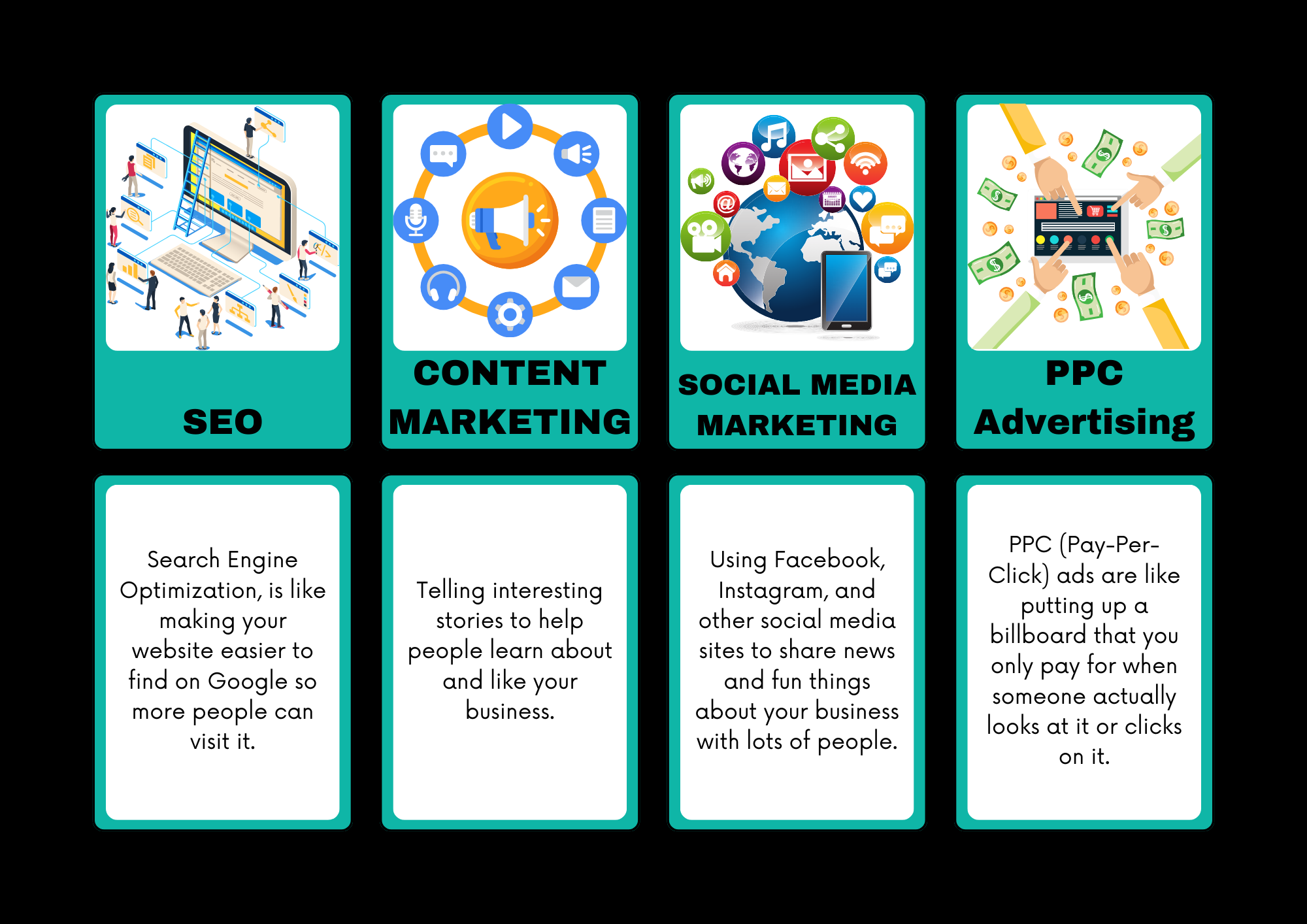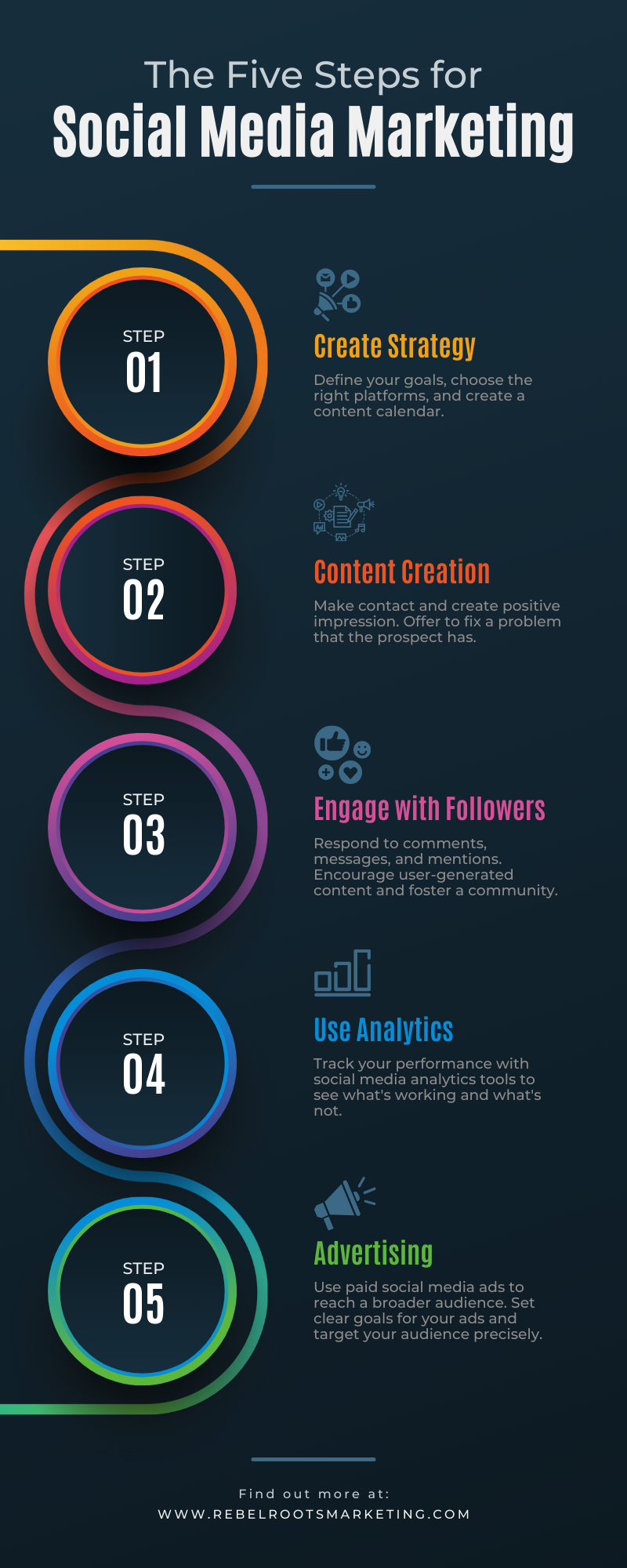Unlock the Power of Business & Marketing:
Insights, Trends, and Strategies for Success

Digital Marketing Strategy: Unfolding the Chaos
Digital Marketing Strategy:
Unfolding the Chaos

Misconceptions of Digital Marketing Strategies
To a small business owner with no in-depth knowledge of digital marketing strategies, it could be seen as just posting on Facebook and other social media platforms and might occasionally stretch to the limits of a website or blog. However, from a digital expert who has been in the industry for well over a decade, an efficient digital marketing strategy is key to success.
What is a Digital Marketing Strategy?
It is a comprehensive plan that uses online platforms and technology to sell products and services and engage with customers. It involves a series of techniques and strategies, and with today's ever-evolving digital landscape, it takes a significant amount of skill. However, lucky for you, you have me, Cheyenne, your Rebel Innovator.
Digital Marketing History
Not too long ago, digital marketing was very simple to use and easy to navigate. The complexities were not so complex, and even those who barely knew how to save a Word document could find their way around how to market their business online.
Small business owners could easily grow their business to any level they wanted to with just a bit of effort in the digital world. However, now, with social media algorithms that automatically rank posts and AI evolving faster than anything else that has hit the digital dance floor, the struggle has become real. Not to mention SPAM. But, I will save that for another blog.
Key Components of a Digital Marketing Strategy
If you are not familiar with these concepts just by reading them, no worries. I will leave video tutorials alongside each component to help guide you if needed.

Key Components:
SEO (Search Engine Optimization)
Content Marketing
Social Media Marketing
PPC Advertising (Pay-Per-Click)
Effects of The Key Components
Small businesses should implement all of these to ensure precise targeting, measurable results, and a return on investment (ROI). These strategies help build strong relationships with your audience.
BEWARE: Search Engine Optimization Can Only Be Optimized ONCE!
I have never in my entire digital life seen so many people claim they can boost SEO, increase SEO, and, my ultimate favorites: “optimizing SEO” or, the one that always raises my eyebrow, “SEO Optimization.” Not only is this grammatically incorrect but it really showcases just how much knowledge of the concept this person actually has. However, they are the ones who get thousands of dollars with no actual results for their customers. Let this be a hint, those who charge a ton for services such as “SEO Optimization” do not provide the results small businesses truly need. Now, let me jump off my soapbox and back on topic. It is more accurate to simply state “SEO” or “optimizing for search engines.”
In addition to the bad grammar, do not let a solo freelancer tell you they can successfully fulfill your SEO needs by simply adjusting your Google Business Profile (GBP) or messing around with your website, or creating some fast AI content for you. That is a big red flag that they have no clue what they are doing. They may have seen a YouTube video or a fast tutorial that made them believe one of these things will significantly increase a small business's SEO. Unfortunately, I must be the bearer of bad news by telling you that it requires a team effort or someone, such as myself, who absolutely LOVES a challenge and spending hours on research and digging through never-ending “rabbit holes” to find the carrot aka THE keyword! It requires a team of SEO experts, content creators, and web developers (full stack, preferably back end over front end, for a later blog) to cover all aspects from technical optimization to content strategy and then link building. I cover these more in-depth in my “Developing Myself" blog.

A small business can easily implement SEO strategies by following these steps:
Keyword Research: Identify relevant keywords that potential customers use to search for your products or services.
Optimize Website Content: Incorporate these keywords naturally into your website's content, including titles, headers, and meta descriptions.
Improve Site Speed: Ensure your website loads quickly by optimizing images, using efficient code, and leveraging browser caching.
Mobile-Friendly Design: Make sure your website is responsive and provides a good user experience on all devices, especially mobile.
Quality Content Creation: Regularly publish valuable and engaging content, such as blog posts or articles, that addresses your audience's needs and interests.
Build Backlinks: Obtain links from reputable websites to your site, which can improve your site's authority and search engine ranking.
Use Analytics: Monitor your website's performance with tools like Google Analytics to track traffic and identify areas for improvement.
I will provide more detailed insights and recommendations as well as videos later on. Be sure to subscribe to our newsletter and get these insights delivered straight to your inbox!
Content Marketing
Misconceptions of Content Marketing
Once again, it seems as though this is another misconception that many have, thinking they can just create AI-generated content without any research or human thought. Content goes way beyond just an image or a few words on a post on social media.
What is Content Marketing?
Content marketing is a strategic approach focused on creating and distributing valuable, relevant, and consistent content to attract and engage a clearly defined audience, ultimately driving profitable customer actions.
Key Elements of Content Marketing:
Creation of Valuable Content: The content produced should be informative, entertaining, or educational to provide real value to the audience. This can include blog posts, videos, infographics, eBooks, whitepapers, and more.

Relevance: The content should be tailored to the interests and needs of the target audience. This requires understanding the audience's pain points, challenges, and preferences.
Consistency: Regularly publishing content helps build and maintain an audience. Consistent posting schedules keep the audience engaged and coming back for more information.
Target Audience: Content marketing is designed to attract a specific group of people. Knowing your audience allows you to tailor content that resonates with them and addresses their specific needs.
Driving Action: Ultimately, content marketing aims to convert engaged audience members into customers. This involves including calls-to-action (CTAs) that guide readers toward making a purchase, signing up for a newsletter, or taking other desired actions.
Overall, content marketing is about building trust and relationships with your audience by providing them with useful and relevant information that meets their needs.
Social Media Marketing
Misconceptions of Social Media Marketing

Many believe social media marketing is as simple as posting regular updates and hoping for the best. However, true social media marketing requires strategic planning, consistent engagement, and detailed analytics.
How to Avoid the Pitfalls
Avoiding these pitfalls involves understanding that social media marketing is not just about frequency but also about quality, targeting, and engagement. Make sure to set clear goals, understand your audience, and use analytics to adjust your strategy.
What is Social Media Marketing?
Social media marketing is the use of social media platforms to connect with your audience to build your brand, increase sales, and drive website traffic. This involves publishing great content, listening to and engaging followers, analyzing results, and running social media advertisements.
How to Implement Social Media Marketing:
Create a Strategy: Define your goals, choose the right platforms, and create a content calendar.
Content Creation: Share a mix of promotional, educational, and entertaining content. Use visuals, videos, and stories to engage your audience.
Engage with Followers: Respond to comments, messages, and mentions. Encourage user-generated content and foster a community.
Use Analytics: Track your performance with social media analytics tools to see what's working and what's not.
Advertising: Use paid social media ads to reach a broader audience. Set clear goals for your ads and target your audience precisely.
PPC Advertising
Misconceptions of PPC Advertising
Many small business owners think PPC (Pay-Per-Click) advertising is too expensive or complex. Some believe it’s just about bidding on keywords and waiting for clicks.
How to Avoid the Pitfalls
Avoid these pitfalls by understanding that PPC requires strategic keyword research, compelling ad copy, and ongoing optimization. It’s not a set-it-and-forget-it strategy.
What is PPC Advertising?

PPC advertising is a model of internet marketing where advertisers pay a fee each time one of their ads is clicked. Essentially, it's a way of buying visits to your site, rather than attempting to “earn” those visits organically.
How to Implement PPC Advertising:
Keyword Research: Identify and bid on relevant keywords that potential customers are searching for.
Ad Creation: Write compelling ad copy that includes a strong call to action.
Landing Pages: Ensure that the landing pages your ads point to are optimized for conversions.
Budget Management: Set a budget and monitor your spending to ensure a good return on investment.
Analytics and Optimization: Use tools like Google Ads to track performance and continually optimize your campaigns.
Stay tuned for more insights and detailed strategies. At RebelRoots Creative Solutions, we are dedicated to empowering businesses with cutting-edge strategies and innovative solutions that challenge conventional norms. We are committed to driving growth, inspiring change, and making a significant impact through our rebellious, revolutionary, and bold approach.
Ready to take your business to the next level? Subscribe to our newsletter and join the revolution!
About RebelRoots Creative Solutions
We are a dynamic marketing agency specializing in web design, logo creation, automated workflows, and advertising. Our mission is to empower businesses with cutting-edge strategies and innovative solutions that challenge conventional norms. We are committed to driving growth, inspiring change, and making a significant impact through our rebellious, revolutionary, and bold approach.
For more tips and strategies, visit our blog regularly and don't forget to follow us on social media for the latest updates or subscribe to out newsletter HERE!
Contact: [email protected] | 980.577.2127


